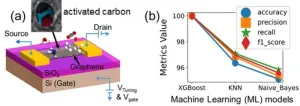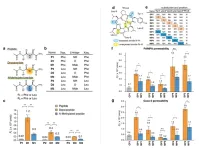(Press-News.org) Deyi Li from the Chinese Association for Artificial Intelligence believes that humans and machines have a mutually beneficial relationship. His paper on machine intelligence, which was published Feb. 15 in Intelligent Computing, a Science Partner Journal, builds on five groundbreaking works by Schrödinger, the father of quantum mechanics, Turing, the father of artificial intelligence, and Wiener, the father of cybernetics.
Schrödinger and beyond: Machines can think and interact with the world as time goes by.
Inspired by Schrödinger’s book “What is Life? The Physical Aspect of the Living Cell,” Li believes that machines can be considered living things. That is, like humans, they decrease the amount of entropy or disorder in their environment through their interactions with the world.
The machines of the agricultural age and the industrial age existed only at the physical level, but now, in the age of intelligence, machines consist of four elements at two different levels: matter and energy at the physical level, and structure and time at the cognitive level. “The machine can be the carrier of thought, and time is the foundation of machine cognition,” Li explained.
Turing and beyond: Machines can think, but can they learn?
In 1936, Turing published what has been called the most influential mathematics paper, establishing the idea of a universal computing machine able to perform any conceivable computation. Such hypothetical computers are called Turing machines. His 1950 paper “Computing Machinery and Intelligence” introduced what is now known as the Turing test for measuring machine intelligence, sparking a debate over whether machines can think. A proponent of thinking machines, Turing believed that a “child machine” could be educated and eventually achieve an adult level of intelligence.
However, given that cognition is only one part of the learning process, Li pointed out two limitations of Turing’s model in achieving better machine intelligence: First, the machine’s cognition is disconnected from its environment rather than connected to it. This shortcoming has also been highlighted in a paper by Michael Woodridge titled “What Is Missing from Contemporary AI? The World.” Second, the machine’s cognition is disconnected from memory and thus cannot draw on memories of past experiences. As a result, Li defines intelligence as the ability to engage in learning, the goal of which is to be able to "explain and solve actual problems."
Wiener and beyond: Machines have behavioral intelligence.
In 1948, Wiener published a book that served as the foundation of the field of cybernetics, the study of control and communication within and between living organisms, machines and organizations. In the wake of the success of the book, he published another, focusing on the problems of cybernetics from the perspective of sociology, suggesting ways for humans and machines to communicate and interact harmoniously.
According to Li, machines follow a control pattern similar to the human nervous system. Humans provide missions and behavioral features to machines, which must then run a complex behavior cycle regulated by a reward and punishment function to improve their abilities of perception, cognition, behavior, interaction, learning and growth. Through iteration and interaction, the short-term memory, working memory and long-term memory of the machines change, embodying intelligence through automatic control. “In essence, control is the use of negative feedback to reduce entropy and ensure the stability of the embodied behavioral intelligence of a machine,” Li concluded.
The strength of contemporary machines is deep learning, which still requires human input, but leverages the ability of devices to use brute force methods of solving problems with insights gleaned directly from big data.
A joint future: from learning to creating
Machine intelligence cannot work in isolation; it requires human interaction. Furthermore, machine intelligence is inseparable from language, because humans use programming languages to control machine behavior.
The impressive performance of ChatGPT, a chatbot showcasing recent advances in natural language processing, proves that machines are now capable of internalizing human language patterns and producing appropriate example texts, given the appropriate context and goal. Since AI-generated texts are increasingly indistinguishable from human-written texts, some are saying that AI writing tools have passed the Turing test. Such declarations provoke both admiration and alarm.
Li is among the optimists who envision artificial intelligence in a natural balance with human civilization. He believes, from a physics perspective, that cognition is based on a combination of matter, energy, structure and time, which he calls “hard-structured ware,” and expressed through information, which he calls “soft-structured ware.” He concludes that humans and machines can interact through multiple channels and modes to gain wisdom and intelligence, respectively. Despite their different endowments in thinking and creativity, this interaction allows humans and machines to benefit from each other's strengths.
END
Machine intelligence and humanity benefit from ‘spiral’ of mutual learning, says AI researcher and proponent of ‘cognitive physics’
2023-03-17
ELSE PRESS RELEASES FROM THIS DATE:
Miracle math determines the dynamically coordinated regulation of edge velocity by Rho GTPases
2023-03-17
Ikoma, Japan – Rho GTPases have a crucial role in the orchestration of cell movements. Cells use Rho GTPases to coordinate cytoskeletal reorganization in dynamically changing environments. Among these RhoGTPases, Cdc42 and Rac1 promote cytoskeletal formation, whereas RhoA is involved in myosin II-mediated cytoskeletal retraction and formation.
Simultaneous live observations of multiple GTPase activities and cell morphology changes by specific biosensors and the resulting spatiotemporal data might help to determine the coordinated regulation of ...
The most beautiful strongly bound dibaryon
2023-03-17
Dibaryons are the subatomic particles made of two baryons. Their formations through baryon-baryon interactions play a fundamental role in big-bang nucleosynthesis, in nuclear reactions including those within stellar environments, and provide a connection between nuclear physics, cosmology and astrophysics. Interestingly, the strong force, which is the key to the existence of nuclei and provides most of their masses, allows formations of numerous other dibaryons with various combinations of quarks. However, we do not observe them abound -- deuteron is the only known stable dibaryon.
To resolve this apparent dichotomy, it is essential to investigate ...
New machine-learning approach enables to identify one molecule in a billion molecules selectively with graphene sensors
2023-03-17
Graphene’s 2D nature, single molecule sensitivity, low noise, and high carrier concentration have generated a lot of interest in its application in gas sensors. However, due to its inherent non-selectivity, and huge p-doping in atmospheric air, its applications in gas sensing are often limited to controlled environments such as nitrogen, dry air, or synthetic humid air. While humidity conditions in synthetic air could be used to achieve controlled hole doping of the graphene channel, this does not adequately mirror the situation ...
ETRI introduces AI tutor who teaches foreign language reading
2023-03-17
The Electronics and Telecommunications Research Institute(ETRI) has developed a reading comprehension education AI technology that allows you to learn foreign language listening, speaking, and reading by talking to an artificial intelligence (AI) tutor. It is expected to be of great help in the spread of AI-based language education services.
The Electronics and Telecommunications Research Institute(ETRI) introduced a reading comprehension AI tutor, an artificial intelligence technology for reading education, that introduced deep learning-based dialog processing technology to reading comprehension education for the first time in the world. Through ...
Burt's Bees nature-based products improve photodamaged and hyperpigmented facial skin
2023-03-17
DURHAM, N.C., March 17, 2023 – Burt’s Bees, the #1 dermatologist recommended natural skin care brand,* announced its latest research findings on the benefits of a topical bakuchiol-containing sunscreen in treating redness and pigmentation of photodamaged facial skin. Burt’s Bees also published research findings on a topical treatment in improving the appearance of post-inflammatory hyperpigmentation associated with acne. These studies, available online via ePoster, have been developed for the American Academy of Dermatology 2023 Annual Meeting (AAD) Mar. 17–21, 2023, ...
Resistant bacteria are a global problem. Now researchers may have found the solution
2023-03-17
Staphylococcus aureus. You may have had it in connection with a wound infection. In most cases, it will pass without treatment, while severe cases may require antibiotics, which kills the bacteria. This is the case for the majority of the population. In fact, many of us – though we feel perfectly fine – carry staphylococci in the nose, a good, moist environment in which the bacteria thrive.
However, more and more staphylococci are becoming resistant to antibiotics (also known as multi resistant staphylococcus aureus or MRSA), and these infections can be difficult to treat.
“Antibiotics resistance ...
An elegant new orchid hiding in plain sight
2023-03-17
It is extremely rare for a new plant species to be discovered in Japan, a nation where flora has been extensively studied and documented. Nevertheless, Professor SUETSUGU Kenji and his associates recently uncovered a stunning new species of orchid whose rosy pink petals bear a striking resemblance to glasswork (Fig. 1). Since it was initially spotted near Hachijo Island in Tokyo Prefecture, the new species has been given the name Spiranthes hachijoensis. Interestingly, it can be found in familiar environments such as lawns and parks, and even in private gardens and on balconies. This research suggests ...
Investigating the effects on amide-to-ester substitutions on membrane permeability of cyclic peptides
2023-03-17
Cyclic peptides often exhibit low membrane permeability which can be significantly improved via amide-to-ester substitutions—as demonstrated by researchers from Tokyo Institute of Technology (Tokyo Tech). The utilization of substitutions shown in this study can be used to develop cyclic peptides with high membrane permeability and oral bioavailability for clinical and therapeutic applications.
Interest in cyclic peptides, a class of organic molecules, has reached a new high recently. Their ability as inhibitors has made them ...
EHRA 2023: The hottest science in heart rhythm disorders
2023-03-17
Date: 17 March 2023
16 to 18 April in Barcelona, Spain and online
Discover what’s new and on the horizon in the prevention and treatment of heart rhythm disorders at EHRA 2023, a scientific congress of the European Society of Cardiology (ESC).
The annual congress of the European Heart Rhythm Association (EHRA), a branch of the ESC, will be held 16 to 18 April at the Fira Gran Via, Hall 8, in Barcelona, Spain and online. Explore the scientific programme.
Novel research ...
Study shines new light on ancient microbial dark matter
2023-03-17
Bacteria are literally everywhere – in oceans, in soils, in extreme environments like hot springs, and even alongside and inside other organisms including humans. They’re nearly invisible, yet they play a big role in almost every facet of life on Earth.
Despite their abundance, surprisingly little is known about many microorganisms that have existed for billions of years.
This includes an entire lineage of nano-sized bacteria dubbed Omnitrophota. These bacteria, first discovered based on short fragments of DNA just 25 years ago, are common in many environments around the world but have been poorly understood. Until now.
An international ...






